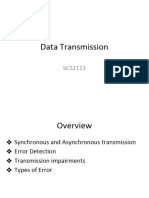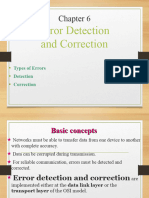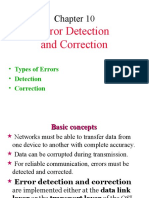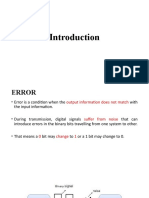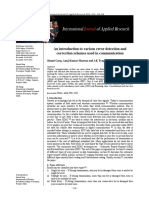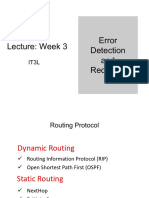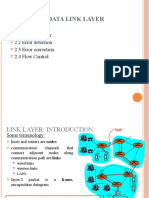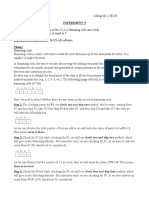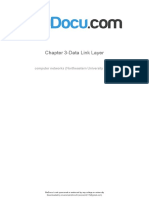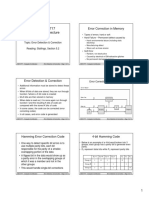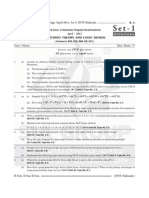ERROR CONTROL,
ERROR DETECTION
AND
ERROR CORRECTION
1
�Introduction
Noise is always present.
If a communications line
experiences too much noise, the
signal will be lost or corrupted.
Communication systems should
check for transmission errors.
�Transmission errors
are caused by electrical interference
from natural sources such as noise,
lightning as well as from man-made
sources such as motors, generators
and power lines.
�Transmission Error
�Once an error is detected, a system
may perform some action.
Some systems perform no error
control, but simply let the data in
error be discarded.
�White Noise
Also known as thermal or Gaussian
noise
Relatively constant and can be
reduced.
If white noise gets to strong, it can
completely disrupt the signal.
�Impulse Noise
One of the most disruptive forms of noise.
Random spikes of power that can destroy one
or more bits of information.
Difficult to remove from an analog signal
because it may be hard to distinguish from the
original signal.
Impulse noise can damage more bits if the bits
are closer together (transmitted at a faster
rate).
�10
�Crosstalk
Unwanted coupling between two
different signal paths.
For example, hearing another
conversation while talking on the
telephone.
Relatively constant and can be
reduced with proper measures.
11
�12
�Echo
The reflective feedback of a transmitted
signal as the signal moves through a
medium.
Most often occurs on coaxial cable.
If echo bad enough, it could interfere
with original signal.
Relatively constant, and can be
significantly reduced.
13
�14
�Jitter
The result of small timing irregularities
during the transmission of digital signals.
Occurs when a digital signal is repeater
over and over.
If serious enough, jitter forces systems to
slow down their transmission.
Reduce jitter - shielding
15
�16
�Delay Distortion
Occurs because the velocity of
propagation of a signal through a
medium varies with the frequency of the
signal. Can be reduced using equalizers
Attenuation
The continuous loss of a signals
strength as it travels through a medium.
17
�As signal travels, it become distorted.
Changes shape
Successive bits may merge, making
reception difficult
Distance
18
�When signal travels, it gets weaker.
If too weak, cannot tell 1s and 0s.
Distance
19
�Unwanted signal from outside sources
Often intermittent, difficult to diagnose
Signal
Strength
Signal
Interference
20
�Error Prevention
To prevent errors from happening, several
techniques may be applied:
- Proper shielding of cables to reduce interference
- Telephone line conditioning or equalization
- Replacing older media and equipment with new,
possibly digital components
- Proper use of digital repeaters and analog
amplifiers
- Observe the stated capacities of the media
21
�22
�DATA COMMUNICATION ERRORS
23
�Single - bit errors when only one bit
within a given data string is in error.
24
�Multiple bit errors when two or more
nonconsecutive bits within a given data
string are in error.
25
�Burst errors when two or more
consecutive bits within a given data
string are in error.
26
�Error performance is the rate in which
error occur.
Bit error rate(BER) actual historical
record of a systems error performance.
Error control can be divided into two
general categories:
Error detection
Error correction
27
�Error Detection
Is the process of monitoring data transmission
and determining when errors have occurred.
Error detection uses the concept of
redundancy, which means adding extra bits
for detecting errors at the destination.
28
�Redundancy a form of error detection in
which it duplicates each data unit for
the purpose of detecting errors.
Is an effective but rather costly means
of detecting errors especially with long
messages.
Redundancy checking adding bits for
the sole purpose of detecting errors.
29
�Redundancy
30
�Four types of redundancy
checks are used
in data communications
31
�Vertical redundancy checking
Is the simplest error detection scheme.
Generally referred to as character
parity or simply parity.
It can detect single bit error.
It can detect burst errors only if the
total number of errors is odd.
32
�33
�Longitudinal redundancy checking
A redundancy error detection scheme that
uses parity to determine if a transmission
error has occurred within a message.
Sometimes called message parity.
LRC increases the likelihood of detecting
burst errors.
If two bits in one data units are damaged
and two bits in exactly the same positions in
another data unit are also damaged, the LRC
checker will not detect an error.
34
�35
�VRC and LRC
36
�Cyclic redundancy checking
The most reliable redundancy checking
technique for error detection.
37
�Checksum
Another relatively simple form of
redundancy error checking where each
character has a numerical value
assigned to it.
The checksum detects all errors
involving an odd number of bits.
It detects most errors involving an even
number of bits.
38
� If one or more bits of a segment are
damaged and the corresponding bit or
bits of opposite value in a second
segment are also damaged, the sums of
those columns will not change and the
receiver will not detect a problem.
39
�40
�Error correction
Two methods
Retransmission
after detecting error
Forward error correction (FEC)
41
�Retransmission
When a receive station requests the
transmit station to resend a
message(or a portion of message)
when the message is received in error.
Often called automatic
retransmission request(ARQ).
Most reliable method of error
correction
42
�Two basic types
1. Discrete uses acknowledgements to
indicate the successful or unsuccessful
reception of data.
Positive the destination station
responds with a positive acknowledgement
when it receives an error-free message.
Negative - the destination station
responds with a positive acknowledgement
when it receives a message containing
errors to call for a retransmission.
43
�Retransmission after time-out
if the sending station does not receive an
acknowledgement after a predetermined
length of time(called a time-out), it
retransmits the message.
2. Continuous used when message are
divided into smaller blocks or frames that
are sequentially numbered and
transmitted in succession, without waiting
for acknowledgement between blocks.
44
�Forward Error Correction
Is the only error correction scheme that
actually detects and corrects
transmission errors when they are
received without requiring a
retransmission.
45
�Consider only a single-bit error in k bits of data
k possibilities for an error
One possibility for no error
#possibilities = k + 1
Add r redundant bits to distinguish these
possibilities; we need
2r k+1
But the r bits are also transmitted along with data;
hence
2r k+r+1
46
�Number of
data bits
k
Number of
redundancy bits
r
Total
bits
k+r
1
2
3
4
5
6
7
10
11
47
Simple, powerful FEC
Widely used in computer memory
Known as ECC memory
error-correcting bits
48
�49
�50
Receiver receives 10010100101
51
�Minimum Hamming Distance is 3
It can correct at most 1 bit error
It can detect at most 2 bit error
But not both!!! (Why?)
SECDED Extended Hamming code with
one extra parity bit
Achieves minimum Hamming distance of 4
Can distinguish between one bit and two bit
errors
52
�53

